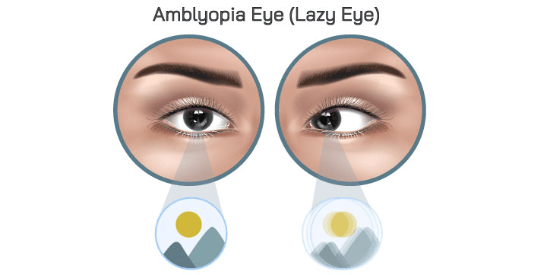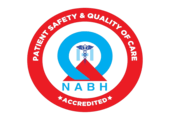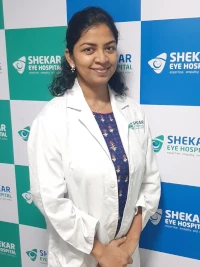Amblyopia, often referred to as “lazy eye,” is a common vision problem that typically begins in childhood. It occurs when one eye doesn’t develop normal vision because it isn’t being used as much as the other eye. This condition can lead to long-term vision problems if not treated early. At Shekar Eye Hospital, we believe in educating our patients about such conditions, so here’s a detailed guide to help you understanding amblyopia, its causes, symptoms, treatments, and prevention.
What is Amblyopia?
Amblyopia is a condition where the brain favours one eye over the other, causing hampered development of vision in the less-used eye. This happens because the brain and the affected eye are not working together properly, leading to decreased vision that cannot be corrected with glasses or contact lenses alone. If untreated, amblyopia can lead to permanent vision impairment in the affected eye.

Causes of Amblyopia
Several factors can cause amblyopia, including:
Refractive Errors: A significant difference in the eye power between the two eyes can lead to amblyopia. For example, if one eye is much more nearsighted, farsighted, or astigmatic than the other, the brain may begin to favour the eye with better vision, leading to amblyopia in the weaker eye.
Strabismus: Strabismus, or misalignment of the eyes, is another common cause of amblyopia. When the eyes are not aligned, the brain may ignore the image from the misaligned eye to avoid double vision, leading to poor vision development in that eye.
Deprivation Amblyopia: This type occurs when something obstructs light from entering and focusing in a child’s eye, such as a cataract, droopy eyelid, or any other blockage that prevents a clear image from reaching the retina. When one eye is deprived of visual experience, it can result in amblyopia if not treated early.
Symptoms of Amblyopia
Amblyopia is often difficult to detect without an eye examination, especially in children who may not realize they are seeing differently from one eye to the other. However, some common symptoms to watch for include:
- Squinting or Shutting One Eye: A child might frequently close one eye to improve vision.
- Difficulty to see clearly
- Close proximity to objects
- Droopy eyelids
- White reflex / white spot in the black part of the eye
- Poor Depth Perception: Difficulty judging distances or depth.
Treatment of Amblyopia
The earlier amblyopia is detected and treated, the better the chances of successful recovery. Treatment is most effective in children under the age of 7, although older children and even adults can still benefit from treatment.
Corrective Eyewear: Glasses or contact lenses can correct refractive errors that cause amblyopia. By providing the weaker eye with a clear image, the brain is encouraged to use it more.
Patching: Covering the stronger eye with a patch forces the brain to rely on the weaker eye, helping to improve its vision. Patching is usually done for several hours each day and is often combined with other treatments.
Atropine Drops: Atropine eye drops can be used to blur the vision in the stronger eye, similar to the effect of a patch. This encourages the brain to use the weaker eye more.
Surgery: In cases where amblyopia is caused by strabismus or cataracts, surgery may be required. Eye muscle surgery can correct the alignment of the eyes, while cataract surgery can remove the obstruction causing vision problems.
Vision Therapy: Exercises designed to improve the coordination and focus of the eyes can also be helpful, with the additional benefit of improving depth perception and binocularity.
Prevention of Amblyopia
Preventing amblyopia involves ensuring that children receive regular eye examinations, especially if there is a family history of the condition or if the child has other risk factors. Early detection is crucial because the brain’s adaptability is greatest in the early years of life.
Regular Eye Check-ups: Early and regular eye exams are the best way to detect amblyopia before it leads to permanent vision problems. It’s recommended that children have their first comprehensive eye exam at 6 months, again at 3 years, and then annually once they start school.
Monitor for Symptoms: Parents should be vigilant in monitoring their children for signs of amblyopia, such as squinting, white reflex, close proximity to objects, difficulty seeing, or difficulty judging distances.
Treat Underlying Conditions: Addressing conditions like strabismus, refractive errors, or cataracts early can prevent the development of amblyopia.
Frequently Asked Questions
1. How long does it take to correct amblyopia in children?
The time required to correct amblyopia varies depending on the severity of the condition and the age at which treatment begins. Some children may see improvement within a few weeks or months, while others may require treatment for several years.
2. Is surgery always required to treat amblyopia?
Surgery is not always necessary for treating amblyopia. In many cases, non-surgical treatments like corrective lenses, patching, vision therapy and atropine drops are sufficient. Surgery is typically reserved for cases where amblyopia is caused by strabismus or cataracts.
Conclusion
Amblyopia is a common yet serious condition that can lead to permanent vision loss if not treated early. The key to successful treatment lies in early detection and intervention. At Shekar Eye Hospital, we emphasize the importance of regular eye check-ups for children and offer a range of treatment options tailored to the needs of each patient. By understanding Amblyopia the causes, symptoms, and treatments of amblyopia, you can take proactive steps to ensure the best possible vision outcomes for your child. Remember, early intervention is the best prevention.






